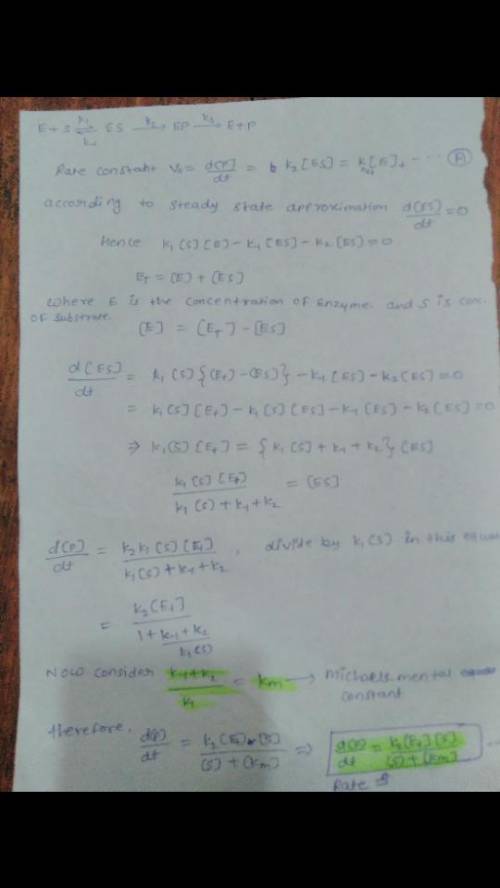
Physics, 05.05.2020 04:22 robert7248
Derive the kinetic equations for Vmax and KM using the transit time and net rate constant method as discussed in class and following the attached handout. (Hint: solve for ET/v by summing the inverse net rate constants, then invert to obtain v/ET and put it in the form of kcatS/[KM S]). Remember that if a step is irreversible, the net rate constant for that step is just the rate constant for that step.

Answers: 3


Other questions on the subject: Physics

Physics, 21.06.2019 22:50, Jasten
A23 kg log of wood begins from rest, 300 m up a sluice (a water track used to transport logs, think of it as an inclined plane with negligible friction) inclined at 20° to the horizontal. after it reaches the flat waterway at the bottom it collides elastically with a 100 kg block of wood initially at rest near the base of the incline. (a) how long does it take the 23 kg log to travel down the incline? (b) what is the speed of the 23 kg log at the bottom of the incline? (c) what are the velocities of both blocks of wood after the collision? (d) what is the total kinetic energy before the collision? (e) what is the kinetic energy of the 23 kg log after the collision? (f) what is the kinetic energy of the 100 kg block of wood after the collision? (g) what is the total kinetic energy after the collision? (h) compare the total initial and total final kinetic energies. is this consistent with what you would expect for elastic collisions? explain!
Answers: 1

Physics, 22.06.2019 02:30, itzyougirllona47
Herbivores, carnivores, and omnivores are all types a. decomposers b. producers c. consumers d. biomes
Answers: 2

Physics, 22.06.2019 06:00, jagmeetcheema
The frequency of vibrations of a vibrating violin string is given by f = 1 2l t ρ where l is the length of the string, t is its tension, and ρ is its linear density.† (a) find the rate of change of the frequency with respect to the following. (i) the length (when t and ρ are constant) (ii) the tension (when l and ρ are constant) (iii) the linear density (when l and t are constant) (b) the pitch of a note (how high or low the note sounds) is determined by the frequency f. (the higher the frequency, the higher the pitch.) use the signs of the derivatives in part (a) to determine what happens to the pitch of a note for the following. (i) when the effective length of a string is decreased by placing a finger on the string so a shorter portion of the string vibrates df dl 0 and l is ⇒ f is ⇒ (ii) when the tension is increased by turning a tuning peg df dt 0 and t is ⇒ f is ⇒ (iii) when the linear density is increased by switching to another string df dρ 0 and ρ is ⇒ f is ⇒
Answers: 3
You know the right answer?
Derive the kinetic equations for Vmax and KM using the transit time and net rate constant method as...
Questions in other subjects:

Mathematics, 31.12.2019 15:31




English, 31.12.2019 15:31









